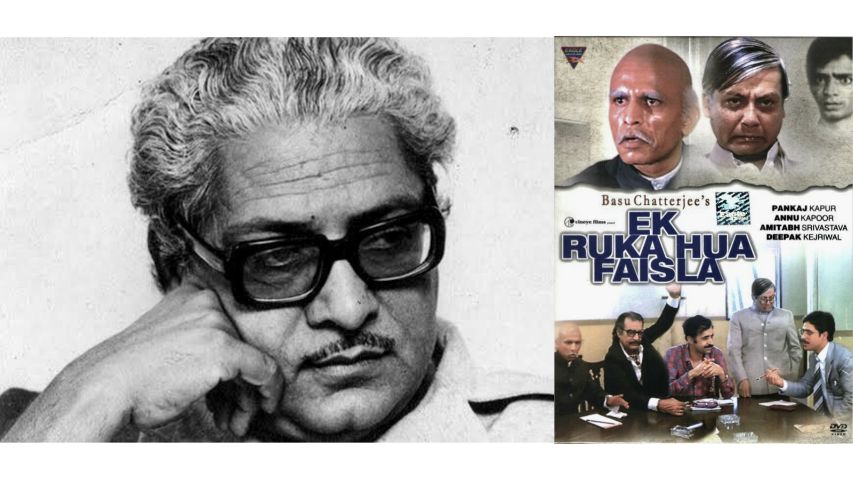-853X543.jpg)
EK RUKA HUA FAISLA (12 ANGRY MEN) IN FOCUS THIS WEEK
by O.P. Srivastava November 18 2023, 12:00 am Estimated Reading Time: 4 mins, 19 secsEk Ruka Hua Faisla (A Pending Decision) is a 1986 Hindi language courtroom drama directed by Basu Chatterjee, writes O.P. Srivastava
It is a remake of the Golden Bear award recipient American film 12 Angry Men (1957), directed by Sidney Lumet, which was an adaptation of a 1954 teleplay of the same name written by Reginald Rose.
Ranjit Kapoor (celebrated theatre director and writer) adapted this play in Delhi for enactment by a group of actors from NSD. The production became a big hit, and the team brought the play to Mumbai and staged it at the Prithvi Theatre, where Basu Chatterjee happened to see it. After watching the play, Basu decided to make it into a film and invited the same group of actors to reprise their roles in it. The entire shoot was wrapped up in a bungalow in Juhu in about a week, and Chatterjee gave each actor Rs 5000/- as well as the opportunity to perform in their first film.
Ek Ruka Hua Faisla was co-scripted by Chatterjee and Kapoor. The latter also wrote the dialogues. The cast includes Deepak Qazir, Amitabh Srivastav, Pankaj Kapur, SM Zaheer, Subhash Udgata, Hemant Mishra, MK Raina, KK Raina, Annu Kapoor, Subbiraj, Shailendra Goyal, Aziz Qureshi and CD Sindhu – most of the actors were from theatre.
KK Raina, Pankaj Kapur, MK Raina, Annu Kapoor and Aziz Qureshi gave some admirable performances. Kapur and KK Raina’s performances enhanced the film’s impact. Ajay Prabhakar did the cinematography for the film, and Kamal A Sehgal edited it. Prabhakar and Sehgal were part of Chatterjee’s core team and worked with him on a number of films. Ek Ruka Hua Faisla is 117 minutes long.
The film tells the story of a jury of 12 men as they deliberate the conviction or acquittal of an 18-year-old defendant based on reasonable doubt, forcing the jurors to question their morals, values and perceptions. The discussion begins with eleven for a ‘guilty’ verdict and one against it. The film explores many techniques of consensus building and the difficulties encountered by this group of men - their varied personalities colour the conclusions, thereby complicating the process of conflict resolution, which is required for a unanimous final verdict.

The film is notable because it takes place entirely within the confines of a single room. The setting is deliberately minimalistic to keep the audience hooked on the debates, discussion and drama. The movie demonstrates how a logical process of patient questioning can elicit change in people’s perceptions. It forces the audience to evaluate their own perceptions by observing the distinct personalities of the jurors, their assumptions, prejudices, interpretations and conclusions.
The story is about how one person can change the mind of a group of people by his convictions backed by logical thinking. The protagonist (juror no. 8, played by KK Raina) approaches the subject of capital punishment with caution. He wants the other jurors to convince him that the defendant is guilty beyond doubt. In the process of discussion, arguments and counter-arguments we see many facets of human behaviour. A few jurors couldn’t care less what the outcome is and the others are of the firm belief that they are always right - they have some fundamental beliefs and assumptions and want to stick to them. Still others have good analytical skills and produce vast amounts of facts and data. They want to justify their conclusion based on facts and figures.
What differentiates these men from the protagonist is the way he draws his inferences using various analytical methods and proves that just because something is generally believed to be correct, it is not always correct. He makes his fellow jurors introspect and distil their own beliefs and thoughts as they try to unravel the truth. During the debate, each juror tries hard to maintain his version of the story and convince the rest of his viewpoint. However, as their conclusions are challenged and dismantled by the protagonist, they change their vote from guilty to not guilty. The twists and turns in the script and the sharp dialogues keep the audience hooked. It is almost as if they are a part of the jury, presented with a case and trying to discover the ultimate reality. The film is used as a case study in management and law schools to understand human behaviour and leadership styles.
Chatterjee, the director and producer, was born in Ajmer, Rajasthan in a Bengali family. His middle class upbringing is reflected in his movies, which explore subjects far removed from the glitz and glamour of mainstream cinema. He arrived in Mumbai in 1948 and started his career as an illustrator and cartoonist for the weekly tabloid Blitz, published by Russi Karanjia.
Eighteen years later, Chatterjee changed his career to filmmaking, and assisted Basu Bhattacharya on Teesri Kasam (1966), which was produced by the renowned Hindi lyricist Shailendra.
Sara Aakash (1969) was Chatterjee’s debut film. He went on to make films that are called middle-of-the-road or middle-class cinema. In fact, the phrase ‘middle-of-the-road’ was coined to describe his middle-class oriented films like Rajnigandha (1974), Chitchor (1976), Chhoti Si Baat (1976), Baaton Baaton Mein (1979) and Khatta Meetha (1978).





-173X130.jpg)

-173X130.jpg)

-173X130.jpg)


-173X130.jpg)